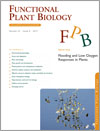
Functional Plant Biology
Volume 44 Number 9 2017
Flooding and Low Oxygen Responses in Plants
FPv44n9_FOFlooding and low oxygen responses in plants
This special issue presents key papers for plant scientists on the quest to further address and improve flood tolerance of terrestrial plants. The papers address low O2 responses in roots, shoots or whole plants in controlled laboratory conditions or in the field situation using natural wetland plants as models as well as economically important crops, such as rice, wheat and barley.
FP16327Anatomical and biochemical characterisation of a barrier to radial O2 loss in adventitious roots of two contrasting Hordeum marinum accessions
A barrier to radial oxygen loss (ROL) in roots is an important adaptation of many wetland plants growing in waterlogged, anoxic soils; however, knowledge of the nature of the barrier is sparse. The ROL barrier enhances longitudinal oxygen diffusion through aerenchyma to the root tip. Our comparison of two Hordeum marinum accessions differing in ROL barrier strength showed that the deposition of suberin into walls of the root exodermis is associated with reduction in loss of oxygen from basal root zones to the external medium.
FP16357Environmental factors constraining adventitious root formation during flooding of Solanum dulcamara
Flooding generally poses a threat to terrestrial plants, but wetland species display adaptations that prevent damage by the adverse conditions imposed by floods. One of these adaptations – formation of adventitious roots that replace the original non-adapted root system – may be severely constrained if insufficient light or contact of leaves with the atmosphere is present during the flooding event. This results in significantly fewer adventitious roots growing out of the stem, and thus poor performance in these stressful conditions.
FP16369Contrasting oxygen dynamics in Limonium narbonense and Sarcocornia fruticosa during partial and complete submergence
Halophytes represent extraordinary strategies of flooding tolerance, most of them poorly understood. Traits associated with internal tissue aeration are often essential to submergence tolerance but the present study shows that other traits may also be relevant in order to sustain growth under recurrent submergence. Understanding traits that confer flooding tolerance is important in times with global climate changes that worldwide are predicted to result in more frequent flooding events.
FP16401Leaf gas film retention during submergence of 14 cultivars of wheat (Triticum aestivum)
Some terrestrial plants, including wheat (Triticum aestivum), possess superhydrophobic leaf surfaces that retain a thin gas film when submerged. We tested gas film retention time of 14 different wheat cultivars and found that wheat could retain the gas films for a minimum of 2 days. We suggest that leaf gas film is a relevant trait to use as a selection criterion to improve the flood tolerance of crops that become temporarily submerged.
FP16395Flood tolerance of wheat – the importance of leaf gas films during complete submergence
Climate changes result in more floods also in regions where the mean precipitation is predicted to decline. Dryland crops such as wheat and barley are particularly vulnerable to submergence stress. Here, we show that superhydrophobic leaf surfaces enhance survival of completely submerged wheat by formation of thin leaf gas films that helps wheat to ‘breathe’ under water.
FP17128No escape? Costs and benefits of leaf de-submergence in the pasture grass Chloris gayana under different flooding regimes
Elongation-induced leaf emergence (escape strategy) is hypothesised to be more beneficial under single long-term submergence than under repeated short-term submergence. We tested this idea in Chloris gayana Kunth. grass. We found that under a single 2-week submergence event, plants accumulated a 2.9-fold higher dry mass than when experiencing the same submergence duration in separate events along 1 week, validating our hypothesis.
FP17054Improvement of submergence tolerance in rice through efficient application of potassium under submergence-prone rainfed ecology of Indo-Gangetic Plain
Potassium (K) is one of the limiting factors that influenced rice growth and yield in submergence prone soils. Here we show that application of K at a higher dose (40 kg K2O ha–1 (basal) + one foliar spray at 0.5% K at panicle initiation stage) was beneficial in improving rice survival and grain yield. This finding will aid in boosting rice productivity in submergence prone rainfed ecology of Eastern Indo-Gangetic Plain.
FP16376A calcineurin B-like protein participates in low oxygen signalling in rice
Rice seeds are able to germinate under water, also thanks to their ability to produce α-amylase under O2 shortage, thus allowing starch degradation. Calcineurin B-like interacting protein kinase 15 (CIPK15) was previously identified as a positive regulator of α-amylase induction during anaerobic germination. In this study, we describe calcineurin B-like proteins 4 (CBL4) as a CIPK15 partner under low O2.
FP16355Metabolomics analysis of postphotosynthetic effects of gaseous O2 on primary metabolism in illuminated leaves
Leaf gas exchange is commonly manipulated using low O2 to suppress photorespiration but the detailed effects of this condition on leaf metabolism have often been disregarded. In this study, we used metabolomics to show metabolic alterations typical of a hypoxic response and that the aspartate pathway, including methionine synthesis, is sensitive to the O2 mole fraction. These results provide evidence that, contrary to common belief, leaf catabolism and biosyntheses are sensitive to gaseous conditions.
FP16385Plant ionic relation and whole-plant physiological responses to waterlogging, salinity and their combination in barley
This work investigated physiological mechanisms conferring barley adaptation to combined waterlogging and salinity stress. Plants exposed to combined stress showed a negative correlation between shoot Na+ accumulation and the extent of salinity damage. Overall, the reported results indicated that K+ reduction in the plants but not stress-induced Na+ accumulation in the shoot was the most critical feature determining the overall plant performance under combined stress conditions.



